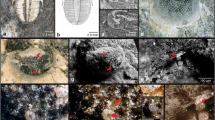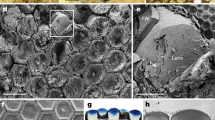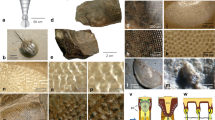Abstract
Despite the status of the eye as an “organ of extreme perfection”1, theory suggests that complex eyes can evolve very rapidly2. The fossil record has, until now, been inadequate in providing insight into the early evolution of eyes during the initial radiation of many animal groups known as the Cambrian explosion. This is surprising because Cambrian Burgess-Shale-type deposits are replete with exquisitely preserved animals, especially arthropods, that possess eyes3,4,5. However, with the exception of biomineralized trilobite eyes, virtually nothing is known about the details of their optical design. Here we report exceptionally preserved fossil eyes from the Early Cambrian (∼515 million years ago) Emu Bay Shale of South Australia, revealing that some of the earliest arthropods possessed highly advanced compound eyes, each with over 3,000 large ommatidial lenses and a specialized ‘bright zone’. These are the oldest non-biomineralized eyes known in such detail, with preservation quality exceeding that found in the Burgess Shale and Chengjiang deposits. Non-biomineralized eyes of similar complexity are otherwise unknown until about 85 million years later6,7. The arrangement and size of the lenses indicate that these eyes belonged to an active predator that was capable of seeing in low light. The eyes are more complex than those known from contemporaneous trilobites and are as advanced as those of many living forms. They provide further evidence that the Cambrian explosion involved rapid innovation in fine-scale anatomy as well as gross morphology, and are consistent with the concept that the development of advanced vision helped to drive this great evolutionary event8.
This is a preview of subscription content, access via your institution
Access options
Subscribe to this journal
Receive 51 print issues and online access
$199.00 per year
only $3.90 per issue
Buy this article
- Purchase on Springer Link
- Instant access to full article PDF
Prices may be subject to local taxes which are calculated during checkout



Similar content being viewed by others
References
Darwin, C. On the Origin of Species by Means of Natural Selection (John Murray, 1859)
Nilsson, D. E. & Pelger, S. A pessimistic estimate of the time required for an eye to evolve. Proc. R. Soc. Lond. B 256, 53–58 (1994)
Briggs, D. E. G., Erwin, D. H. & Collier, F. J. The Fossils of the Burgess Shale (Smithsonian Institution Press, 1994)
Hou, X.-G. et al. The Cambrian Fossils of Chengjiang, China: The Flowering of Early Animal Life (Blackwell, 2004)
Conway-Morris, S. The Crucible of Creation: The Burgess Shale and the Rise of Animals (Oxford Univ. Press, 1998)
Ritchie, A. Ainiktozoon loganense Scourfield, a protochordate? from the Silurian of Scotland. Alcheringa 9, 117–142 (1985)
van der Brugghen, W., Schram, F. R. & Martill, D. M. The fossil Ainiktozoon is an arthropod. Nature 385, 589–590 (1997)
Parker, A. On the origin of optics. Opt. Laser Technol. 43, 323–329 (2011)
Haug, J. T., Maas, A. & Waloszek, D. Ontogeny of two Cambrian stem crustaceans, Goticaris longispinosa and Cambropachycope clarksoni . Palaeontographica Abt. A 289, 1–43 (2009)
Plotnick, R. E., Dornbos, S. Q. & Chen, J.-Y. Information landscapes and sensory ecology of the Cambrian radiation. Paleobiology 36, 303–317 (2010)
García-Bellido, D. C. et al. The bivalved arthropods Tuzoia and Isoxys with soft-part preservation from the lower Cambrian Emu Bay Shale Lagerstätte (Kangaroo Island, Australia). Palaeontology 52, 1221–1241 (2009)
Gehling, J. G., Jago, J. B., Paterson, J. R., García-Bellido, D. C. & Edgecombe, G. D. The geological context of the lower Cambrian (Series 2) Emu Bay Shale Lagerstätte and adjacent stratigraphic units, Kangaroo Island, South Australia. Aust. J. Earth Sci. 58, 243–257 (2011)
Paterson, J. R., Edgecombe, G. D., García-Bellido, D. C., Jago, J. B. & Gehling, J. G. Nektaspid arthropods from the lower Cambrian Emu Bay Shale Lagerstätte, South Australia, with a reassessment of lamellipedian relationships. Palaeontology 53, 377–402 (2010)
Briggs, D. E. G. & Nedin, C. The taphonomy and affinities of the problematic fossil Myoscolex from the Lower Cambrian Emu Bay Shale of South Australia. J. Paleontol. 71, 22–32 (1997)
McCormick, T. & Fortey, R. A. Independent testing of a paleobiological hypothesis: the optical design of two Ordovician pelagic trilobites reveals their relative paleobathymetry. Paleobiology 24, 235–253 (1998)
Zhang, X.-G. & Clarkson, E. N. K. The eyes of Lower Cambrian eodiscid trilobites. Palaeontology 33, 911–932 (1990)
Harzsch, S. & Hafner, G. Evolution of eye development in arthropods: Phylogenetic aspects. Arthropod Struct. Dev. 35, 319–340 (2006)
Wehner, R. in Comparative Physiology and Evolution of Vision in Invertebrates: C 287–616 (Springer, 1981)
Oldham, S. et al. The Drosophila insulin/IGF receptor controls growth and size by modulating PtdInsP 3 levels. Development 129, 4103–4109 (2002)
Freeman, M. Reiterative use of the EGF receptor triggers differentiation of all cell types in the Drosophila eye. Cell 87, 651–660 (1996)
Land, M. F. & Nilsson, D.-E. Animal Eyes (Oxford Univ. Press, 2002)
Snyder, A. W. in Comparative Physiology and Evolution of Vision in Invertebrates A (ed. Autrum, H. ) 225–313 (Springer, 1979)
Warrant, E. & Nilsson, D.-E. Invertebrate Vision (Cambridge Univ. Press, 2006)
Harzsch, S., Melzer, R. R. & Müller, C. H. G. Mechanisms of eye development and evolution of the arthropod visual system: The lateral eyes of myriapoda are not modified insect ommatidia. Org. Divers. Evol. 7, 20–32 (2007)
Daley, A. C., Budd, G. E., Caron, J.-B., Edgecombe, G. D. & Collins, D. The Burgess Shale anomalocaridid Hurdia and its significance for early euarthropod evolution. Science 323, 1597–1600 (2009)
Vannier, J. et al. Tuzoia: morphology and lifestyle of a large bivalved arthropod of the Cambrian seas. J. Paleontol. 81, 445–471 (2007)
Clarkson, E., Levi-Setti, R. & Horváth, G. The eyes of trilobites: The oldest preserved visual system. Arthropod Struct. Dev. 35, 247–259 (2006)
Schoenemann, B. & Clarkson, E. N. K. Eyes and vision in the Chengjiang arthropod Isoxys indicating adaptation to habitat. Lethaia 10.1111/j.1502–3931.2010.00239.x (30 September 2010)
Schoenemann, B. & Clarkson, E. N. K. Analysis of fossilised eye systems and its relevance to palaeobiology. Entomol. Gen. 31, 287–299 (2008)
Parker, A. In the Blink of an Eye: The Cause of the Most Dramatic Event in the History of Life (The Free Press, 2003)
Acknowledgements
We thank P. and C. Buck for access to and assistance at the fossil site; N. Schroeder, M. Gemmell, R. Atkinson, M. A. Binnie and numerous others (Supplementary Table 3) for help with excavations and curatorial assistance; A. Netting, P. Hudson and Adelaide Microscopy for imaging; D. Birch and G. Brock for SEM-EDS analysis; A. Baonza and J. F. de Celis for discussions on arthropod eye development; R. Fortey and A. Parker for comments and the Australian Research Council (grant LP0774959), South Australian Museum, Spanish Ministry of Science (RYC2007-00090 and grant CGL2009-07073), Beach Energy and Sealink Pty Ltd for funding.
Author information
Authors and Affiliations
Contributions
All authors contributed directly to excavation and interpretation of fossil specimens, analysis and writing the paper. J.B.J., J.R.P. and M.S.Y.L. compiled comparative eye data, M.S.Y.L. conducted the stereomicroscopy and J.R.P. conducted the SEM-EDS analyses and digital photography.
Corresponding authors
Ethics declarations
Competing interests
The authors declare no competing financial interests.
Supplementary information
Supplementary Information
The file contains Supplementary Tables 1-3, Supplementary References and Supplementary Figures 1-4 with legends. (PDF 1044 kb)
Rights and permissions
About this article
Cite this article
Lee, M., Jago, J., García-Bellido, D. et al. Modern optics in exceptionally preserved eyes of Early Cambrian arthropods from Australia. Nature 474, 631–634 (2011). https://doi.org/10.1038/nature10097
Received:
Accepted:
Published:
Issue Date:
DOI: https://doi.org/10.1038/nature10097
This article is cited by
-
The median eyes of trilobites
Scientific Reports (2023)
-
The genome of Nautilus pompilius illuminates eye evolution and biomineralization
Nature Ecology & Evolution (2021)
-
Emergent Bioanalogous Properties of Blockchain-based Distributed Systems
Origins of Life and Evolution of Biospheres (2021)
-
Fossil insect eyes shed light on trilobite optics and the arthropod pigment screen
Nature (2019)
-
Collective behaviour in 480-million-year-old trilobite arthropods from Morocco
Scientific Reports (2019)
Comments
By submitting a comment you agree to abide by our Terms and Community Guidelines. If you find something abusive or that does not comply with our terms or guidelines please flag it as inappropriate.



